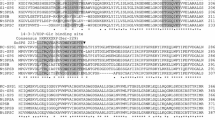Abstract
A cDNA library from RNA of senescing cucumber cotyledons was screened for sequences also expressed in cotyledons during post-germinative growth. One clone encodes ATP-dependent phosphoenolpyruvate carboxykinase (PCK; EC 4.1.1.49), an enzyme of the gluconeogenic pathway. The sequence of a fulllength cDNA predicts a polypeptide of 74397 Da which is 43%, 49% and 57% identical to bacterial, trypanosome and yeast enzymes, respectively. The cDNA was expressed in Escherichia coli and antibodies raised against the resultant protein. The antibody recognises a single polypeptide of ca. 74 kDa, in extracts of cotyledons, leaves and roots. The cucumber genome contains a single pck gene. In the seven-day period after seed imbibition, PCK mRNA and protein steady-state levels increase in amount in cotyledons, peaking at days 2 and 3 respectively, and then decrease. Both accumulate again to a low level in senescing cotyledons. This pattern of gene expression is similar to that of isocitrate lyase (ICL) and malate synthase (MS). When green cotyledons are detached from seedlings and incubated in the dark, ICL and MS mRNAs increase rapidly in amount but PCK mRNA does not. Therefore it seems unlikely that the glyoxylate cycle serves primarily a gluconeogenic role in starved (detached) cotyledons, in contrast to post-germinative and senescing cotyledons where PCK, ICL and MS are coordinately synthesised. While exogenous sucrose greatly represses expression of icl and ms genes in dark-incubated cotyledons, it has a smaller effect on the level of PCK mRNA.
Similar content being viewed by others
References
Allen RD, Trelease RN, Thomas TL: Regulation of isocitrate lyase gene expression in sunflower. Plant Physiol 86: 527–532 (1988).
Becker W, Apel K: Differences in gene expression between natural and artificially induced leaf senescence. Planta 189: 74–79 (1993).
Beevers H: Metabolic production of sucrose from fat. Nature 191: 433–436 (1991).
Comai L, Dietrich RA, Maslyar DJ, Baden CS, Harada JJ: Coordinate expression of transcriptionally regulated isocitrate lyase and malate synthase genes in Brassica napus L. Plant Cell 1: 293–300 (1989).
De Bellis L, Nishimura M: Development of enzymes of the glyoxylate cycle during senescence of pumpkin cotyledons. Plant Cell Physiol 32: 555–561 (1991).
Dieuaide M, Brouquisse R, Pradet A, Raymond P: Increased fatty acid β-oxidation after glucose starvation in maize root tips. Plant Physiol 99: 595–600 (1992).
Draper J, Scott R, Armitage P, Walden R (eds): Plant Genetic Transformation and Gene Expression: A Laboratory Manual. Blackwell Scientific Publications, Oxford (1988).
Feinberg AP, Vogelstein B: A technique for radiolabelling DNA restriction endonuclease fragments to high specific activity. (Addendum). Analyt Biochem 137: 266–267 (1984).
Graham IA, Smith LM, Brown JWS, Leaver CJ, Smith SM: The malate synthase gene of cucumber. Plant Mol Biol 13: 673–684 (1989).
Graham IA, Smith LM, Leaver CJ, Smith SM: Developmental regulation of expression of the malate synthase gene in transgenic plants. Plant Mol Biol 15: 539–549 (1990).
Graham IA, Leaver CJ, Smith SM: Induction of malate synthase gene expression in senescent and detached organs of cucumber. Plant Cell 4: 349–357 (1992).
Gut H, Matile P: Apparent induction of enzymes of the glyoxylate acid cycle in senescent barley leaves. Planta 176: 548–550 (1988).
Joshi CP: An inspection of the domain between putative TATA box and translation start site in 70 plant genes. Nucl Acids Res 15: 6643–6653 (1987).
Kozak M: Compilation of the sequences upstream from the translation start site in eukaryotic mRNAs. Nucl Acids Res 12: 857–872 (1984).
Kudielka RA, Theimer RR: Repression of glyoxysomal enzyme activities in anise (Pimpinella anisum L.) suspension cultures. Plant Sci Lett 31: 245–252 (1983).
Leegood RC: Carbon dioxide concentrating mechanisms. In: Lea PJ, Leegood RC (eds) Plant Biochemistry and Molecular Biology, pp. 47–72. John Wiley, Chichester (1993).
Leegood RC, ap Rees T: Phosphoenolpyruvate carboxykinase and gluconeogenesis in cotyledons of Cucurbita pepo. Biochim Biophys Acta 524: 207–218 (1979).
McGrain MM, Jun JS, Patel YM, Hanson RW: Metabolic control of gene expression: in vivo studies with transgenic mice. Trends Biochem Sci 17: 40–44 (1992).
McLaughlin JC: Synthesis and regulation of glyoxylate cycle enzymes in detached and senescent cucumber cotyledons. Ph. D. thesis, University of Edinburgh (1994).
Medina V, Pontarollo R, Glaeske D, Tabel H, Goldie H: Sequence of the pckA gene of Escherichia coli K-12: relevance to genetic and allosteric regulation regulation and homology of E. coli phosphoenolpyruvate carboxykinase with enzymes from Trypanosoma brucei and Saccharomyces cerevisiae. J Bact 172: 7151–7156 (1990).
Osteras M, Finan TM, Stanley J: Site-directed mutagenesis and DNA sequence of pckA of Rhizobium NGR234, encoding phosphoenolpyruvate carboxykinase: gluconeogenesis and host-dependent symbiotic phenotype. Mol Gen Genet 230: 257–269 (1991).
Parsons M, Smith JM: Trypanosome glycosomal protein P60 is homologous to phosphoenolpyruvate carboxykinase (ATP). Nucl Acids Res 17: 6411 (1989).
Pistelli L, De Bellis L, Alpi A: Peroxisomal enzyme activities in attached senescing leaves. Planta 184: 151–153 (1991).
Sambrook J, Fritsch EF, Maniatis T: Molecular Cloning: A Laboratory Manual. Cold Spring Harbor Press, New York (1989).
Stucka R, Valdes-Hevia MD, Gancedo C, Schwarzlose C, Feldmann H: Nucleotide sequence of the phosphoenolpyruvate carboxykinase gene from Saccharomyces cerevisiae. Nucl Acids Res 16: 10926 (1988).
Smith SM, Leaver CJ: Glyoxysomal malate synthase of cucumber: Molecular cloning of a cDNA and regulation of enzyme synthesis during germination. Plant Physiol 81: 762–767 (1986).
Smith DB, Johnson KS: Single-step purification of polypeptides expressed in Escherichia coli as fusions with glutathione S-transferase. Gene 67: 31–40 (1988).
Wanner L, Keller F, Matile P: Metabolism of radiolabelled galactolipids in senescent barley leaves. Plant Sci 78: 199–206 (1991).
Weir EM, Reizman H, Grienbenberger JM, Becker WM, Leaver CJ: Regulation of glyoxysomal enzymes during germination of cucumber. Eur J Biochem 112: 469–477 (1980).
Author information
Authors and Affiliations
Rights and permissions
About this article
Cite this article
Kim, DJ., Smith, S.M. Molecular cloning of cucumber phosphoenolpyruvate carboxykinase and developmental regulation of gene expression. Plant Mol Biol 26, 423–434 (1994). https://doi.org/10.1007/BF00039551
Received:
Accepted:
Issue Date:
DOI: https://doi.org/10.1007/BF00039551




